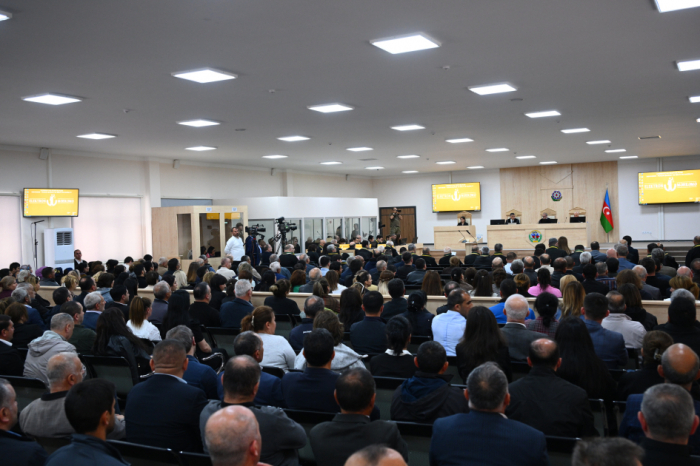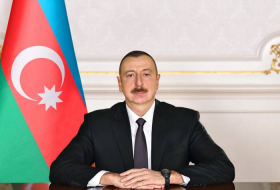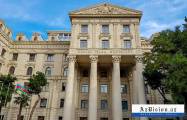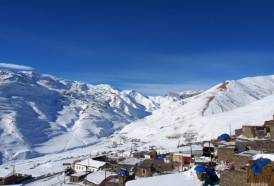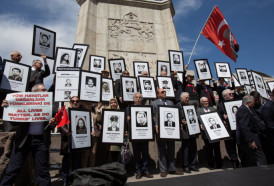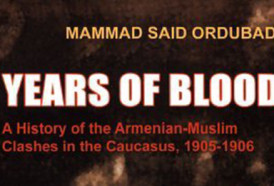The open court session in the criminal case against Armenian citizens Arayik Harutyunyan, Arkadi Ghukasyan, Bako Sahakyan, Davit Ishkhanyan, David Babayan, Levon Mnatsakanyan, and others, who are accused of crimes against peace and humanity, war crimes, including preparing and waging aggressive war, genocide, violating the laws and customs of war, as well as terrorism, financing terrorism, forcibly seizing power, forcibly retaining it, and committing numerous other crimes as a result of Armenia's military aggression against Azerbaijan, continued on May 16.
At the Baku Military Court, under the chairmanship of Judge Zeynal Agayev, with judges Jamal Ramazanov and Anar Rzayev (alternate judge Gunel Samedova), each of the defendants was provided with an interpreter in their known language and with lawyers for their defense.
The session was attended by the defendants, their lawyers, some of the victims, their legal successors and representatives, as well as prosecutors defending the state prosecution.
Tugay Rahimli, Assistant to the Prosecutor General for Special Assignments, began investigation of documents reflecting the destruction of cultural heritage in the sovereign territories of Azerbaijan once occupied by Armenia.
An article published in foreign media outlet on April 7, 1993, regarding the occupation of Kalbajar by the Armenian army, was investigated through a translator.
Citing the article, headlined "Attacks in the Caucasus triggers a new wave of refugees," it was mentioned that the "successful" advance of the Armenian army in Kalbajar caused thousands of Azerbaijanis to be forced to flee their land. "On Monday, women and children in Kalbajar tried to board helicopters. About 39,000 people fleeing the fighting were registered in refugee centers," the article noted.
"Murov Pass, Azerbaijan, April 6, 1993. They (Azerbaijanis - ed.) appeared as black dots across the snowy plains. Three men, descending the northern slope of the mountain pass at an altitude of nine thousand feet (about 2,743 meters), were moving forward, seeking refuge on their own land. On a path resembling a forest road, it turned out that they were five people.
A man in his 30s, exhausted, and two women in their 20s, carrying babies in their arms. They were all freezing, in shock after six days of hiking in the forest and mountains. In the South Caucasus, the Armenian army captured Kalbajar over the weekend, forcing thousands to flee and creating a large-scale internal displacement crisis.
The occupation of Kalbajar by Armenian troops enabled them (the Armenians - ed.) to take control over a large area connecting Karabakh with Armenia from north to south. The first communication was established last year in Lachin, this road used to deliver troops and supplies to Karabakh," the article mentioned.
“Not only the Government of Azerbaijani, but also many people who were direct witnesses of the occupation of Kalbajar state that the attack was carried out directly from the territory of Armenia and that the new northern corridor opened to Karabakh is more than 100 kilometers long, which in fact means the complete annexation of the Kalbajar district. The United States condemns Armenia for new attacks in the Caucasus.
Today, the United States strongly condemned Armenia for seizing territories located in the northwestern part of neighboring Azerbaijan following the attacks launched 11 days ago. As noted in a statement by US Secretary of State Warren Christopher, the administration called on the government of Yerevan to immediately withdraw its forces. He also mentioned that a letter of protest was presented to Armenian President Levon Ter-Petrosyan on Monday," the article emphasized.
"Izvestia" newspaper edition published on April 2, 1993, was further examined.
“The Armenian army had reached the vicinity of the Kalbajar district. The offensive was launched from the directions of Armenia and Karabakh. The Kalbajar district has been under a complete blockade, and has already been cut off the roads linking it to Azerbaijan. The city is subjected to the continuous rocket shelling and air bombardment. There are multiple casualties among peaceful civilians. The fates of thousands remain unknown,” the article said.
Thus, both foreign sources examined at the court hearings confirmed the participation of the Armenian armed forces in occupation of Kalbajar and killing of civilians.
Then, the resolutions adopted by the UN Security Council in 1993 were investigated with the help of an English language translator.
As part of the proceedings, the report presented by the International Human Rights Organization were reviewed, detailing the ruthless attack and murdering of civilians by the Armenian armed forces in 1993.
The report outlines the forced expulsion of Azerbaijani civilians from the territories captured in Karabakh, the taking of civilians as hostages, and the indiscriminate shooting of people attempting to flee the violence.
The report also documents widespread looting and the destruction of civilian property, specifically noting the capture and plundering of Aghdam by Armenian forces in July 1993. It emphasizes the involvement of Armenian armed groups in hostilities across Karabakh and highlights that the shelling and bombing of civilian areas caused massive displacement.
“The civilian population was taken hostage, their property looted and set ablaze,” the report states.
Furthermore, the report identifies serious violations of the Geneva Conventions, citing evidence of war crimes committed by the Republic of Armenia. It includes instances of mistreatment and murder of hostages and war veterans, as well as breaches of military regulations.
Next, the state prosecutor presented photo and video materials, highlighting the destruction and devastation of the Azerbaijani districts, cities, towns, and villages following the Armenian occupation, the obliteration of Azerbaijani cultural, historical, and religious monuments, infrastructure, civilian property, and cemeteries.
It was noted that during the occupation, Azerbaijan’s religious monuments, including mosques were not only destroyed, but also insulted being used as a barn for pigs.
The hearings also saw the protocols on inspections of the liberated districts, cities and villages, as well as photos and videos attached to those protocols.
Subsequently, the expert opinions on preliminary investigation were announced.
We recall that as a result of the aggressive war, the historical and cultural monuments belonging to the cultural heritage of the Republic of Azerbaijan were turned into targets of attack, used to support military operations, deliberately set on fire on a large scale, shelled and blown up with artillery, and partially or completely destroyed through other physical means. Additionally, acts of theft, looting, and vandalism were committed, causing great material damage to Azerbaijan and its people.
The court process will continue on May 19.
A total of 15 Armenian nationals are being charged with numerous crimes involving direct leadership and participation of the Armenian state, its state bodies, military forces and illegal armed formations, verbal and written instructions, orders and assignments, provision of material and technical support, central governance, as well as the exercise of rigorous control, with the aim of committing military aggression and acts of terror against the Republic of Azerbaijan in the territory of Azerbaijan in violation of domestic and international law, and involving Robert Sedraki Kocharyan, Serzh Azati Sargsyan, Vazgen Mikaeli Manukyan, Vazgen Zaveni Sargsyan, Samvel Andraniki Babayan, Vitali Mikaeli Balasanyan, Zori Hayki Balayan, Seyran Mushegi Ohanyan, Arshavir Surenovich Garamyan, Monte Charles Melkonyan and others, including criminal acts committed during the course of the war of aggression waged by the aforementioned criminal group.
The said persons, i.e. Arayik Vladimiri Harutyunyan, Arkadi Arshaviri Ghukasyan, Bako Sahaki Sahakyan, Davit Rubeni Ishkhanyan, David Azatini Manukyan, Davit Klimi Babayan, Levon Henrikovich Mnatsakanyan, Vasili Ivani Beglaryan, Erik Roberti Ghazaryan, Davit Nelsoni Allahverdiyan, Gurgen Homeri Stepanyan, Levon Romiki Balayan, Madat Arakelovich Babayan, Garik Grigori Martirosyan, Melikset Vladimiri Pashayan, are being charged under Articles 100 (planning, preparing, initiating and waging a war of aggression), 102 (attacking persons or organizations enjoying international protection), 103 (genocide), 105 (extermination of the population), 106 (enslaving), 107 (deportation or forced displacement of the population), 109 (persecution), 110 (enforced disappearance of people), 112 (deprivation of liberty contrary to international law), 113 (torture), 114 (mercenary service), 115 (violation of the laws and customs of warfare), 116 (violation of international humanitarian law during armed conflict), 118 (military robbery), 120 (intentional murder), 192 (illegal entrepreneurship), 214 (terrorism), 214-1 (financing terrorism), 218 (creation of a criminal association (organization)), 228 (illegal acquisition, transfer, sale, storage, transportation and possession of weapons, their components, ammunition, explosives and devices), 270-1 (acts threatening aviation security), 277 (assassination of a state official or public figure), 278 (forcible seizure and retention of power, forcible change of the constitutional structure of the state), 279 (creation of armed formations and groups not provided for by law) and other articles of the Criminal Code of the Republic of Azerbaijan.
More about:








